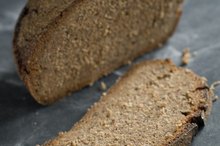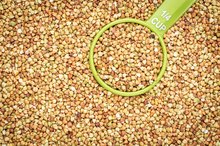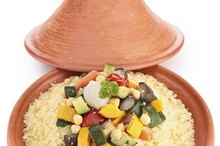What does fact checked mean?
At Healthfully, we strive to deliver objective content that is accurate and up-to-date. Our team periodically reviews articles in order to ensure content quality. The sources cited below consist of evidence from peer-reviewed journals, prominent medical organizations, academic associations, and government data.
- Academy of Nutrition and Dietetics: Celiacs -- Avoid These Grains
- Longevity and Healthspan: Consumption of a Low Glycaemic Index Diet in Late Life Extends Lifespan of Balb/c Mice With Differential Effects on DNA Damage
- Longevity and Healthspan: Consumption of a Low Glycaemic Index Diet in Late Life Extends Lifespan of Balb/c Mice With Differential Effects on DNA Damage
The information contained on this site is for informational purposes only, and should not be used as a substitute for the advice of a professional health care provider. Please check with the appropriate physician regarding health questions and concerns. Although we strive to deliver accurate and up-to-date information, no guarantee to that effect is made.
The Essential Guide to the Glycemic Index and Gluten Free Living
The glycemic index or GI was developed to measure carbohydrates and how quickly they are released into the body after eating food 1. Foods classed as low GI release their energy slowly and have values of 55 or less. Medium GI foods have values between 56 and 69, and high GI foods have GI values of 70 or above. A value of 100 means the food has releases energy as fast as pure glucose.
Effects on the Blood Sugar
If you eat a high-GI food you may experience a sudden surge of energy which quickly drains away, leaving you feeling tired, weak and hungry again. This is because the quick releasing carbohydrate caused your blood sugar levels to rise and fall sharply. To avoid this and keep your blood sugar levels stable, try low-GI foods.
Benefits of Low-GI Foods
Low Glycemic & Gluten-Free Foods
Learn More
According to the GI Symbol Program, including low-GI foods in your diet can help you to feel fuller for longer after meals meaning you are less likely to snack or overeat. This can help you to either lose weight or maintain a healthy weight. Low-GI foods can help reduce your risk of developing type-2 diabetes, heart disease and certain eye diseases. You may also find your skin improves, along with your ability to perform physically and mentally. A study in the March 2013 issue of "Longevity and Healthspan" reports that a diet of low-glycemic foodsnot only keeps blood sugar levels elevated but it may also extend your lifespan by 12 percent, noting the results of their study performed on mice.
- According to the GI Symbol Program, including low-GI foods in your diet can help you to feel fuller for longer after meals meaning you are less likely to snack or overeat.
Gluten-free Living
Gluten is a protein found in wheat, rye and barley. If you suffer from gluten intolerance or celiac disease, you will find removing gluten from your diet can ease your symptoms. According to the Academy of Nutrition and Dietetics website, you should avoid foods containing barley, bulgur, durham, farina, kamut, matzo meal, rye, semolina, spelt and wheat when following a gluten-free diet.
GI Values of Gluten-free Products
Can Diabetics Eat Rye Bread & Pumpernickel Bread?
Learn More
The GI of gluten-free pasta varies depending on the variety; however, all have similar values to the glutinous varieties. According to the Glycemic Index Database, general gluten-free pasta has a GI of 54, gluten-free corn pasta has one of 68 and gluten-free rice pasta has a GI of 51 1.
The GI of gluten-free spaghetti and gluten-free bread is slightly higher than that of the glutinous varieties. The GI of gluten-free spaghetti is 51, while spaghetti is 42. Similarly, the GI of gluten-free multigrain bread is 79, while the wheat-based version is 62, and white bread is 80 compared to 70 for the wheat-based version.
- The GI of gluten-free pasta varies depending on the variety; however, all have similar values to the glutinous varieties.
- Similarly, the GI of gluten-free multigrain bread is 79, while the wheat-based version is 62, and white bread is 80 compared to 70 for the wheat-based version.
Gluten-free Eating
When following a gluten-free diet, base your meals around large-flake or rolled oats, buckwheat and quinoa, as these have low GI values. You can lower the overall GI value of gluten-free breads and pastas by adding plenty of protein such as chicken, fish or eggs, low-GI vegetables and beans or pulse vegetables to your meal.
Related Articles
References
- Glycemic Index: Home
- Longevity and Healthspan: Consumption of a Low Glycaemic Index Diet in Late Life Extends Lifespan of Balb/c Mice With Differential Effects on DNA Damage
- Diamanti A, Capriati T, Basso MS, et al. Celiac disease and overweight in children: an update. Nutrients. 2014;6(1):207-20. doi:10.3390/nu6010207
- Massachusetts General Hospital, Center for Celiac Research: "Celiac Disease FAQ"
- Bardella MT et al. Body Composition and Dietary Intakes in Adult Celiac Disease Patients Consuming a Strict Gluten-Free Diet. The American Journal of Clinical Nutrition. 2000 Oct;72(4):937-9.
- Cheng J et al. Body Mass Index in Celiac Disease: Beneficial Effect of a Gluten-Free Diet. Journal of Clinical Gastroenterology. 2010 Apr;44(4):267-71.
- Fasano A et al. Non-Celiac Gluten Sensitivity. Gastroenterology. 2015 May;148(6):1195-204.
Writer Bio
Kim Ford has been writing professionally since 2008 with her work appearing in various publications and on websites, including "The News" and "Sportsister." She received a pre-entry certificate in newspaper journalism with a news associate/sports-beat emphasis from the National Council for the Training of Journalists.









